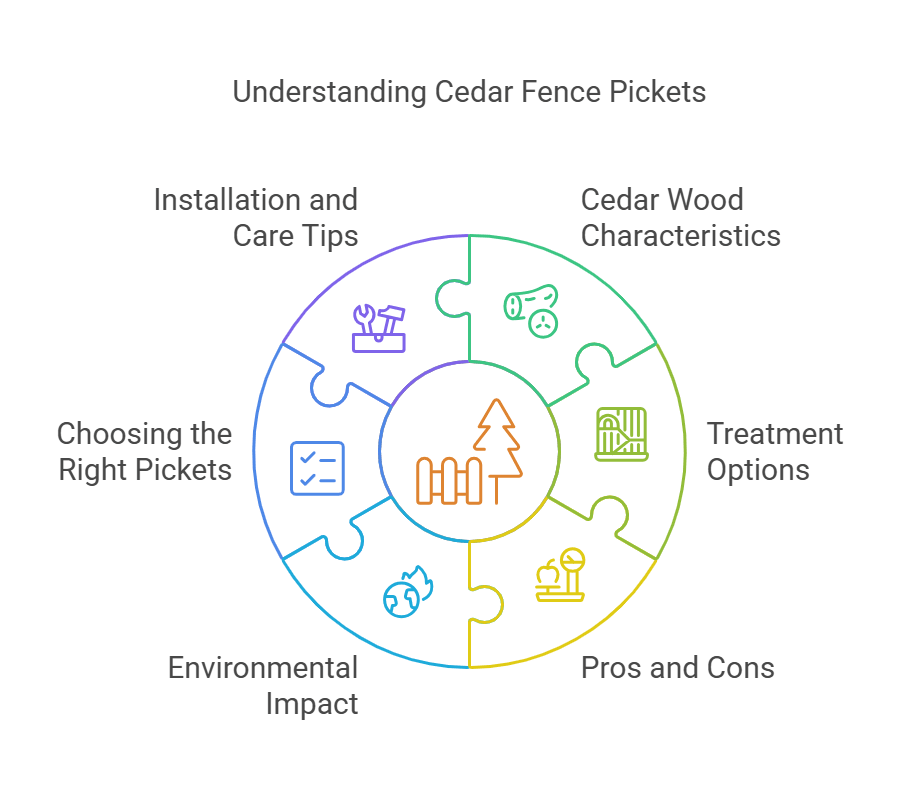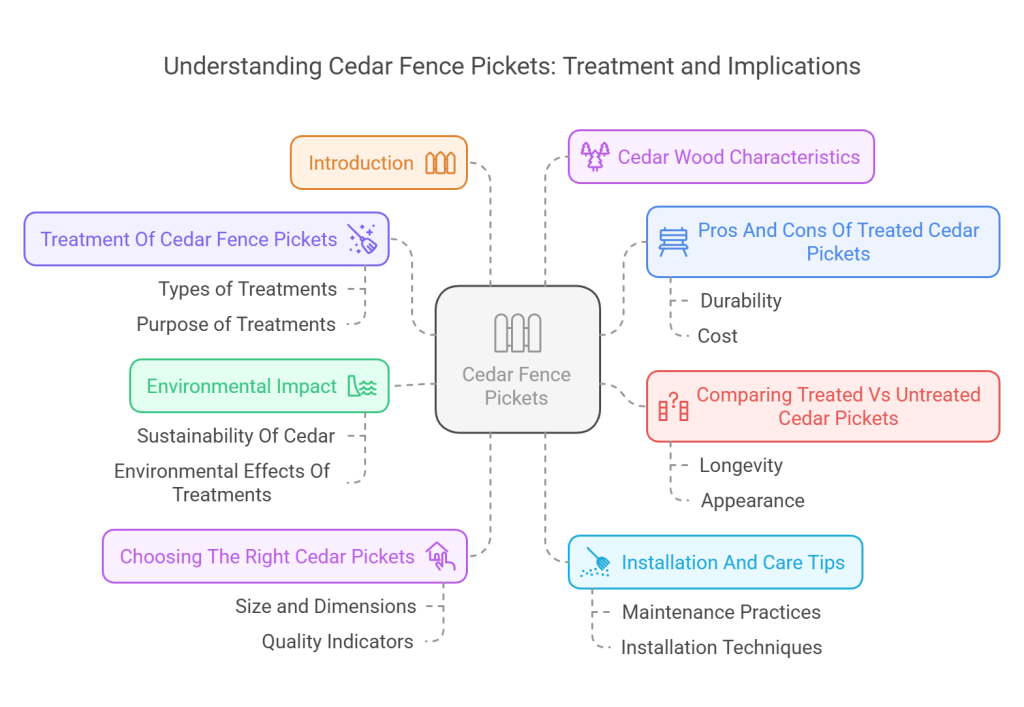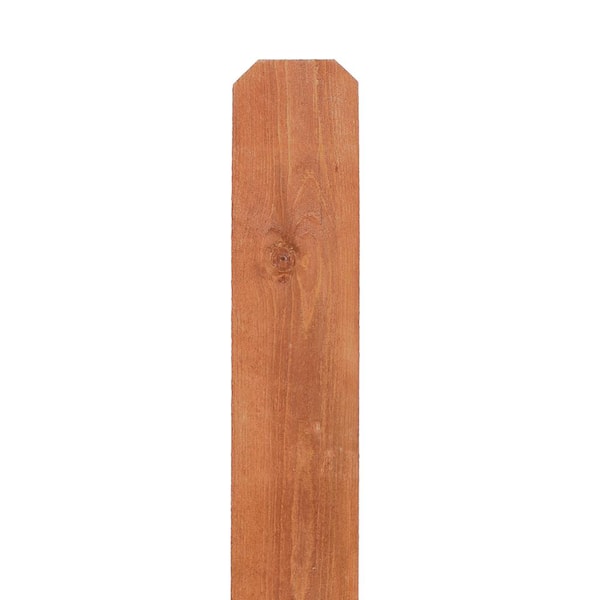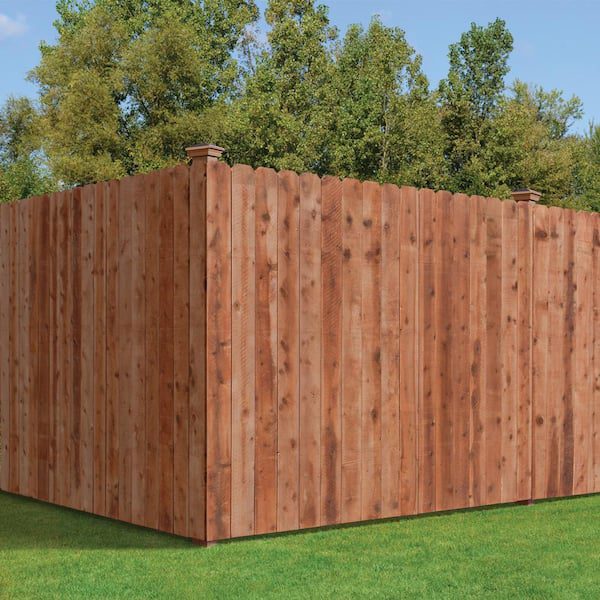Yes, cedar fence pickets can be treated. Treatment helps to extend their lifespan.
But not all cedar pickets are treated the same way. Cedar is a popular choice for fencing due to its natural beauty and durability. Homeowners often wonder whether cedar fence pickets need extra treatment. Treated cedar pickets can resist rot, insects, and weather damage better.
Understanding the benefits and types of treatments available can help you make an informed decision. This blog will explore the treatment options for cedar fence pickets, ensuring your fence stands strong and looks great for years. Read on to learn more about the importance of treating cedar fence pickets and how it impacts their longevity and performance.
Introduction To Cedar Fence Pickets
Cedar fence pickets are made from cedar wood. They are strong and durable. These pickets have a natural beauty. The wood has a pleasant smell. Cedar pickets resist insects and rot. This makes them last longer. People like cedar for its rich color. Over time, it turns a silver-gray. This gives a classic look to fences.
Cedar fence pickets are used for privacy fences. They keep yards private and safe. These pickets also work well for garden fences. Gardens look neat and tidy. Cedar is good for decorative fences too. It adds charm to any home. Some people use them for pet enclosures. Pets stay safe inside the fence. Cedar pickets are versatile and useful.

Cedar Wood Characteristics
Cedar wood is known for its natural durability. It lasts a long time. Cedar does not rot easily. This makes it good for fences. Cedar wood is tough. It can handle bad weather.
Cedar wood resists decay and insects. It has oils that keep bugs away. These oils also stop rot. Cedar fence pickets stay strong. They do not need many chemicals. This makes them safe to use. Cedar wood is a good choice.
Treatment Of Cedar Fence Pickets
Cedar fence pickets can be treated in different ways. The most common treatment is pressure treating. This adds chemicals to the wood. This helps to resist rot and bugs. Some pickets are also treated with stains. Stains help to protect the wood from sun and rain. Another method is sealing. Sealing makes the wood water-resistant. Each treatment has its own benefits. Choose the one that fits your needs.
Treatments protect the cedar pickets. Rot and bugs can damage untreated wood. Treated pickets last longer. Weather can also harm the wood. Sun, rain, and snow cause the wood to break down. Treatments help to keep the wood strong. This means fewer repairs. Also, treated wood looks better. It keeps its color and shape. Treatments are a good idea for many reasons.

Credit: www.blicksfencing.com
Pros And Cons Of Treated Cedar Pickets
Treated cedar pickets last longer than untreated ones. They resist rot and insects better. This saves money on repairs. Treated wood is also stronger. It can handle harsh weather. This means your fence stays sturdy. The treatment helps keep the wood’s color. This makes your fence look nice for years. Treated pickets are a good choice for a low-maintenance fence.
Treated cedar pickets can be more expensive. They may cost more than untreated wood. Some treatments use chemicals. These can be harmful. Especially to the environment. The chemicals might also affect pets. Or even plants near the fence. Treated wood can sometimes look different. The treatment may change its color. It might not match other wood in your yard. Over time, the chemicals may wear off. This could lead to more maintenance.
Comparing Treated Vs Untreated Cedar Pickets
Treated cedar pickets last longer. They resist rot and insects. Maintenance is easier. They need less care. Untreated pickets can rot. They attract bugs. You will need to replace them more often. Maintenance is harder. They need regular care. Choose treated for less work over time.
Treated cedar pickets cost more upfront. But they last longer. You save money long-term. Untreated pickets are cheaper at first. But you spend more on repairs. You will need to replace them sooner. Consider your budget. Think about future costs. Treated may be cheaper in the end.

Environmental Impact
Cedar fence pickets are often untreated, making them environmentally friendly. Using untreated wood reduces chemical exposure and promotes natural decomposition. This choice supports a healthier ecosystem.
Sustainability Of Cedar
Cedar is a sustainable wood. It grows fast and is renewable. Cedar trees are often replanted after cutting. This helps maintain forests. Using cedar does not harm the environment much. Its natural oils make it resistant to bugs and rot. This reduces the need for chemical treatments.
Environmental Effects Of Treatments
Some cedar fence pickets are treated. Treatments can protect wood from decay. But, treatments can also harm the environment. Chemicals used can be toxic. They may pollute soil and water. Untreated cedar is safer for nature. It relies on its natural oils for protection. Choosing untreated cedar is an eco-friendly option.
Choosing The Right Cedar Pickets
Cedar pickets come in different grades. High-grade cedar is durable and looks great. Low-grade cedar is cheaper but may not last long. Check if the wood is treated. Treated wood lasts longer. It can resist bugs and rot. Look for uniform color and few knots. This shows better quality.
Measure your space first. You need the right amount of pickets. Choose pickets that are straight. Bent pickets are hard to install. Buy some extra pickets. This helps in case of mistakes.

Credit: www.allaroundfenceanddecks.com
Installation And Care Tips
Place cedar fence pickets evenly. Use a level to keep them straight. Set posts deep in the ground. Use concrete to hold them firm. Leave gaps between pickets. This allows air to flow. Airflow prevents rotting. Secure pickets with galvanized nails. These nails resist rust. Rust weakens the fence.
Inspect your fence often. Look for loose pickets. Tighten any loose nails. Remove debris near the base. Debris holds moisture. Moisture causes rot. Apply a wood sealant yearly. This protects against weather. Check for insect damage. Treat the wood if needed. Clean the fence with water. Use a mild soap if dirty. Rinse well to remove soap.

Credit: www.homedepot.com
Frequently Asked Questions
Are Cedar Fence Pickets Naturally Resistant To Rot?
Yes, cedar fence pickets are naturally resistant to rot and decay. This makes them a durable choice for fencing.
Do Cedar Fence Pickets Require Treatment?
Cedar fence pickets do not require treatment. Their natural oils protect them from insects and moisture damage.
How Long Do Cedar Fence Pickets Last?
Cedar fence pickets can last up to 20-30 years. Proper maintenance can extend their lifespan even further.
Can I Paint Or Stain Cedar Fence Pickets?
Yes, you can paint or stain cedar fence pickets. It helps to enhance their appearance and longevity.
Conclusion
Cedar fence pickets offer beauty and durability. They are typically untreated. Treatment can protect against insects and decay. Consider your climate and needs. Untreated cedar ages gracefully. Treated pickets provide extra protection. Choose based on your priorities. Both options have benefits.
Cedar fences are a timeless choice. Make an informed decision for your fence. Enjoy the natural charm of cedar.

